Ibike Korea People-to-People Program
 Photo essay: Jinju to
Geoje-si
Photo essay: Jinju to
Geoje-si
Jinju to Tongyeong (50mi, 80km) After the last of the mainland hills,
head out to some islands – but there still will be hills.
Points of Interest: aqua-culture, turtle ship
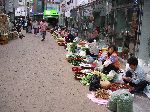
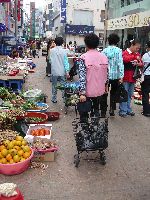 The
market in Jinju starts early. Individual
vendors set-up at dawn, before many buyers are in area. As
time passes the shoppers come, many bring wheeled carts to carry home the days
purchases.
The
market in Jinju starts early. Individual
vendors set-up at dawn, before many buyers are in area. As
time passes the shoppers come, many bring wheeled carts to carry home the days
purchases.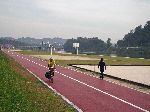
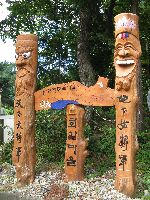
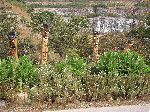 Jang-seung,
"totem poles", are a male-female pair of wooden spirit posts representing the
earthly and heavenly gods. Usually locate at the entrance to a village on the
mainland to scare off evil. They are smiling scary..
Jang-seung,
"totem poles", are a male-female pair of wooden spirit posts representing the
earthly and heavenly gods. Usually locate at the entrance to a village on the
mainland to scare off evil. They are smiling scary..
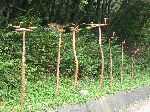 So-ttae,
wooden birds on poles. Traditionally these marked the boundaries of a village
and were for good luck. Contemporarily the are used more as decorative art.
So-ttae,
wooden birds on poles. Traditionally these marked the boundaries of a village
and were for good luck. Contemporarily the are used more as decorative art.
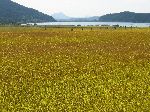
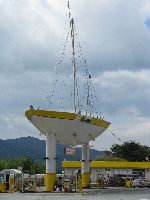
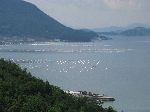
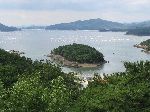 Before we got our first good view of the South Sea, we could see the roof of a
gas station decorated to look like a boat. The gas station was part of a
large rest area that offer great views of the South Sea and the extensive aquaculture
that was being carried on there. In the photo to the right, all of the
white specks are floats that are supporting various kinds of marine farming
operations such as oysters, scallops, mussels, and sea weed.
Before we got our first good view of the South Sea, we could see the roof of a
gas station decorated to look like a boat. The gas station was part of a
large rest area that offer great views of the South Sea and the extensive aquaculture
that was being carried on there. In the photo to the right, all of the
white specks are floats that are supporting various kinds of marine farming
operations such as oysters, scallops, mussels, and sea weed.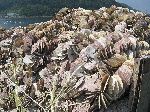
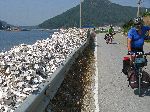 The
primary marine culture activity in this area is oysters. There were long
piles of oyster shells along the roadside (right). Some were loose and
some were strung together to be hung from floating racks for spats to attach to
and mature.
The
primary marine culture activity in this area is oysters. There were long
piles of oyster shells along the roadside (right). Some were loose and
some were strung together to be hung from floating racks for spats to attach to
and mature.
There were also what looked like scallop shells strung together (far left). There are a couple of methods of cultivating scallops that involve hanging them from racks and ropes, but these set-up don't fit our understanding of any of the methods..
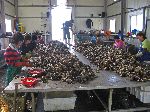
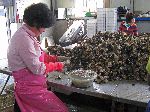 There
were several long workshops along the road where women surrounded long tables
and shucked oysters. Cultural note: They seemed to be able to keep up a
constant conversation. Can they do it for a full work shift, every day?
There
were several long workshops along the road where women surrounded long tables
and shucked oysters. Cultural note: They seemed to be able to keep up a
constant conversation. Can they do it for a full work shift, every day?
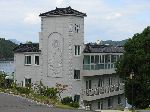
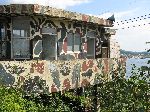
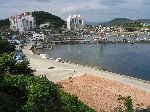
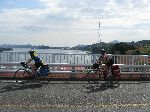 The
south coast has a very active economy. Beside fishing and aquaculture
there is boat building. We avoiding the most industrial of the boat
building areas because these include the mammoth operations largest ship builder
in the world. The smaller harbors and ports were nice enough and
sufficient.
The
south coast has a very active economy. Beside fishing and aquaculture
there is boat building. We avoiding the most industrial of the boat
building areas because these include the mammoth operations largest ship builder
in the world. The smaller harbors and ports were nice enough and
sufficient.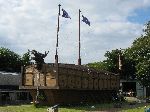
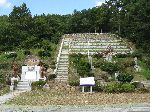
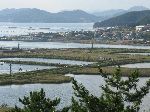
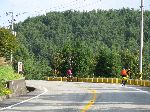
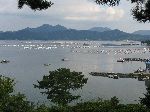 Whether
the route was along the shoreline of through the forest crossing the island, the
back roads of Geoje Island offered delightful views and experience.
Whether
the route was along the shoreline of through the forest crossing the island, the
back roads of Geoje Island offered delightful views and experience.

 Please
contact us if you would like to be added to
Ibike's mailing list or have questions, comments, corrections or criticism. (Also, please let us know how you learned about us and
found this site.) Privacy policy.
Please
contact us if you would like to be added to
Ibike's mailing list or have questions, comments, corrections or criticism. (Also, please let us know how you learned about us and
found this site.) Privacy policy.
![]() IBF Homepage
IBF Homepage ![]() Ibike Programs
Ibike Programs
![]() Ibike Schedule
Ibike Schedule
![]() Search
Search



